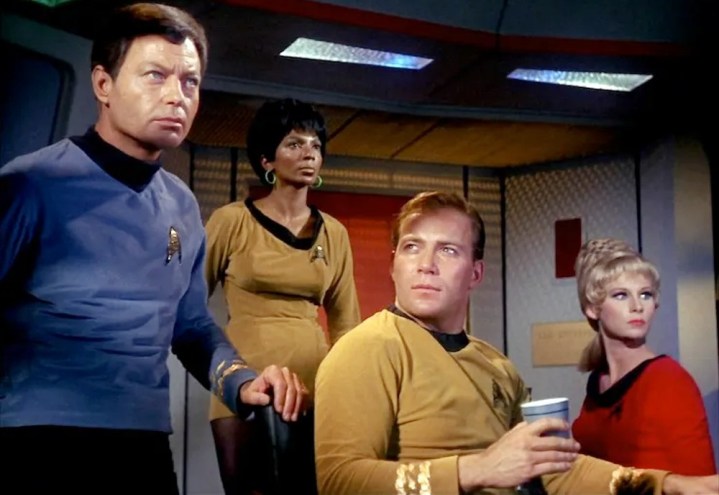
It’s hard to imagine today, but back in the late 1960s, the original Star Trek was not considered a hit. The ambitious science fiction series was constantly on the brink of cancellation and was cut short only three years into its planned five-season run.
- 10. Mirror, Mirror (season 2, episode 4)
- 9. A Taste of Armageddon (season 1, episode 24)
- 8. The Menagerie, Parts I and II (season 1, episodes 12 and 13)
- 7. The Doomsday Machine (season 2, episode 6)
- 6. The Corbomite Maneuver (season 1, episode 11)
- 5. The Devil in the Dark (season 1, episode 26)
- 4. The Trouble with Tribbles (season 2, episode 15)
- 3. Where No Man Has Gone Before (season 1, episode 4)
- 2. The City on the Edge of Forever (season 1, episode 29)
- 1. Balance of Terror (season 1, episode 15)
However, it’s important to put Trek’s apparent failure into historical context as, given that most markets in the U.S. had only three television channels to choose from, even a low-rated show like Star Trek was being watched by about 20% of everyone watching television on a Thursday night, or roughly 10 million households. This year’s season of HBO’s Succession was viewed by roughly 8 million households a week, which makes it a hit by today’s standards. Star Trek’s audience only grew once it went into reruns in the early 1970s, and by the time Star Trek: The Motion Picture hit theaters in 1979, it was a genuine cultural phenomenon. Today, the Star Trek franchise is considered one of the crown jewels of the Paramount library.
Though arguably outshined by its most prosperous spinoff, Star Trek: The Next Generation, Star Trek: The Original Series holds up remarkably well for a vision of our future imagined nearly 60 years in our past. It’s a space adventure series that tackles social or political issues from what was, at the time, a daring and progressive perspective informed by the contemporary civil rights movement, sexual revolution, and backlash against the Vietnam War. Conveying these values through fanciful science fiction didn’t only allow its writers to get away with a lot of subversive messages, it also delivered them in a way that remains fun to watch decades later — fun enough that fans are willing to forgive when its ideas, or its special effects, crumble under modern scrutiny.
These 10 episodes, however, unquestionably stand the test of time, and thanks to the continuity-light nature of mid-20th century television, any one of them could be your first Star Trek episode. (Be aware, however, that the order in which classic Trek episodes are listed varies depending on the source. For our purposes, we’re using the numbering from streaming service Paramount+.)
10. Mirror, Mirror (season 2, episode 4)

Even if you’ve never seen an episode of Star Trek, you’re bound to be at least a little familiar with Mirror, Mirror through cultural osmosis. In this 1967 classic, Captain Kirk (William Shatner), Dr. McCoy (DeForest Kelley), Lt. Commander Scott (James Doohan), and Lt. Uhura (Nichelle Nichols) are accidentally transported to an alternate universe, where they encounter dastardly evil versions of their beloved shipmates. Instead of the benevolent United Federation of Planets, this ship serves the fascist Terran Empire, which threatens to annihilate a peaceful planet for refusing to submit to itsrule. Our heroes are forced to pose as their evil counterparts while they search for a way home and try to avert the genocide they’ve been ordered to perform.
This all sounds heavier than it is — like much of classic Trek, Mirror Mirror is very camp, with brightly colored costumes, over-the-top performances, and a general sense of fun. The cast is clearly having a ball playing the wicked versions of their characters (or playing the good versions of their characters playing the wicked versions), and it’s no wonder why multiple future incarnations of Trek would return to the Mirror Universe, usually for wacky adventure episodes. (For a more grim and brutal take on this same concept, visit the back half of Star Trek: Discovery’s first season.) However, Mirror, Mirror still comes complete with Trek’s famous humanist optimism, as Kirk tries to convince this universe’s menacing, bearded Spock (Leonard Nimoy) that regimes ruled by fear are unsustainable and, therefore, illogical. Given enough time, peace and cooperation will always win out over hate and violence.
9. A Taste of Armageddon (season 1, episode 24)

A Taste of Armageddon may not appear on many “Best Of” lists, but it’s 100% pure, uncut Star Trek. In this episode, Kirk and company visit Eminiar VII, a seemingly peaceful planet that is, in fact, embroiled in a centuries-long war with a neighboring world. Rather than fire actual bombs at each other, the combatants conduct simulated attacks, determine the hypothetical death toll, and then order the “dead” citizens to report to disintegration chambers. When Kirk and his landing party are recorded as casualties, they decide to put an end to Eminiar VII’s supposedly “civilized” method of warfare.
While Kirk arguably has no right to interfere with how this sovereign planet conducts its affairs, the point of A Taste of Armageddon is to reflect on America’s attempt to make constant military conflict more palatable, or even invisible to the average American. Or, in a larger sense, it’s a commentary on the ease with which a culture can become accustomed to death and violence, so long as it’s part of an established routine. Because these simulated bombings leave homes, industry, and even the military infrastructure itself totally unharmed, it’s easy to forget that Eminiar VII is even at war — that is, until it claims your life or the life of someone you love.
When even these losses are framed as necessary sacrifices to maintain normalcy, it minimizes the incentive to make peace. Kirk (and, by extension, writers Robert Hamner and Gene L. Coon) argues that war is revolting no matter how much you dress it up, and that it must be brutal, terrifying, and omnipresent for all involved, or else it will never stop. The past half-century of perpetual U.S. military intervention abroad has proven this thesis to be chillingly accurate.
8. The Menagerie, Parts I and II (season 1, episodes 12 and 13)
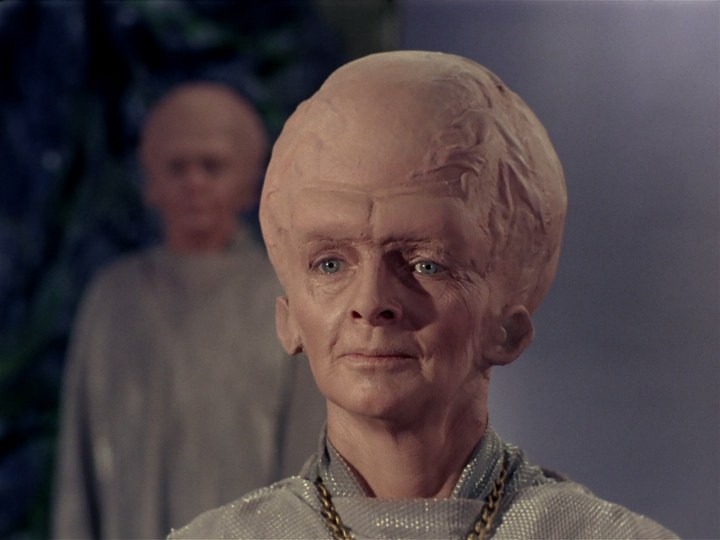
If you’re watching Star Trek on Paramount+, you’ll notice that the episode it has listed as “season 1, episode 1,” The Cage, isn’t exactly the show you were expecting. Instead of the famous Captain James T. Kirk, the USS Enterprise is under the command of Captain Christopher Pike (Jeffrey Hunter), and apart from Mr. Spock — who smiles?! — the rest of the crew is also unfamiliar. That’s because The Cage is Star Trek’s original pilot episode, which was rejected by NBC, leading to a second pilot being commissioned with a new cast and modified tone. The Cage wouldn’t air as its own episode until 1988, but during production of Star Trek’s first season in 1966, a budget crunch led to writer/creator Gene Roddenberry repurposing footage from the already-completed pilot into a new script in the form of flashbacks.
This fiscally minded decision endowed Star Trek and its characters with a history, instantly making the universe a bigger and more interesting place. The two-part Menagerie sees Spock, the only remaining character from the original cast, commandeer the Enterprise for the sake of its previous captain, Christopher Pike. On the way to a forbidden planet, Spock uses mysterious footage from an adventure 13 years in the past to explain his rash actions.
If you’ve already watched The Cage, then The Menagerie will seem like a glorified clip show, in which Kirk and company spend half the runtime watching a previous episode. However, before the streaming era, The Cage was usually the last episode of The Original Series that a fan would see, rather than the first. In recent years, however, The Cage and The Menagerie have taken on a new role, as bookends to the adventures of Christopher Pike, as portrayed by Anson Mount on modern spinoff Star Trek: Strange New Worlds. Strange New Worlds (as well as the second season of Star Trek: Discovery) take place after The Cage, but before The Menagerie, allowing us to get to know Kirk’s predecessor in his own context, as well as developing the bond between Pike and Spock that will eventually drive the Vulcan to mutiny. Even without any of this context, however, The Menagerie is an exciting two-hour event, an eras-spanning mystery that will make you wonder why NBC passed on the Star Trek pilot in the first place.
7. The Doomsday Machine (season 2, episode 6)
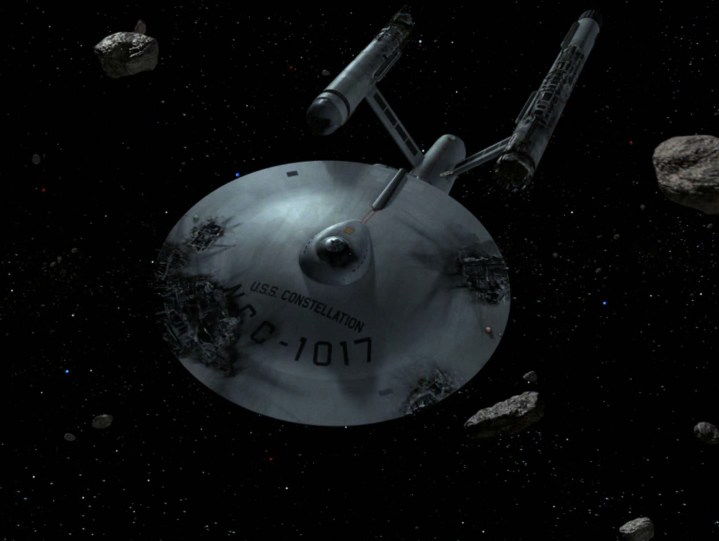
Due to the production constraints of 1960s television, the original Star Trek didn’t often aim for large-scale, awe-inspiring space action. The Doomsday Machine is the closest that classic Trek ever came to “epic,” and as compelling a story as it is, it’s also Exhibit A as to why such a thing was impractical with the resources available. Though its original effects required no small amount of ingenuity (they couldn’t afford to give their Enterprise model battle damage, so they bought one off the rack from a toy store and distressed it), the results look mighty corny on a modern high-definition television.
Still, the episode gained fame as boasting the largest-scale action of the series, as the Enterprise teams up with her badly damaged sister ship, the USS Constellation, to take on a huge planet-eating weapon. It also presages a theme that would become common in Star Trek feature films, as the Constellation’s grief-stricken Commodore Matt Decker (guest star William Windom) embarks on a foolhardy quest for revenge against the monster that bested him. (Trek would revisit Herman Melville’s Moby-Dick in Star Trek II: The Wrath of Khan and Star Trek: First Contact.)
The episode still works in a cheesy B-movie sort of way, which some fans would argue is the way it should still be enjoyed. However, when the series was remastered for high definition in the mid-2000s, the decision was made to recreate most of the special effects shots for the series using modern technology, since the originals were never expected to hold up to modern standards. Most of these recreations are very faithful, to the extent that uninitiated viewers might not even realize they’d been replaced. In the case of The Doomsday Machine, however, the producers and effects artists returned to the episode’s original script and attempted to realize writer Norman Spinrad’s initial vision for the space battle sequences. The team at CBS Digital doesn’t sacrifice the overall aesthetic of the series, but they do give us a peek at what The Doomsday Machine — and by extension, the entire Original Series — might have looked like with a feature film budget.
6. The Corbomite Maneuver (season 1, episode 11)
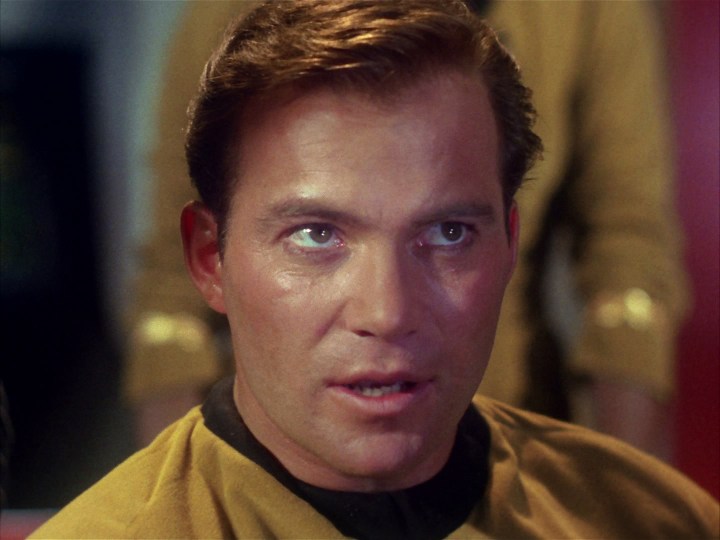
There may be no better introduction to the character of James T. Kirk than The Corbomite Maneuver. The first episode produced after the series was picked up (though it didn’t air until later in the season), The Corbomite Maneuver finds the Enterprise at the mercy of a massive alien vessel and accused of trespassing in its territory. Unable to outrun or outgun his mysterious adversary, Kirk does what he will later become famous for doing — he cheats. Or, rather, he changes the conditions of the contest from one of technological superiority to one of cunning and guile. In the process, we get to learn a bit about how each of the main characters handles the intense stress of a seemingly hopeless scenario, contrasted against the more relatable Everyman Lt. Bailey (guest star Anthony Call). Though the action rarely leaves the bridge of the Enterprise, it is, in its own way, one of the most thrilling episodes of the series.
Moreover, The Corbomite Maneuver sets the tone for Star Trek as a series. It’s an hour of adventure that is punctuated by moments of thoughtful introspection, warm friendship, and corny jokes. Its depiction of Starfleet and the Enterprise are clearly inspired by military tradition, but the message of the episode is one of compassion and patience rather than conquest. These are scientists, not soldiers, and while they experience fear and doubt, none of their human frailties are a match for their curiosity. If this is what the future of humanity looks like, we want to be a part of it.
5. The Devil in the Dark (season 1, episode 26)
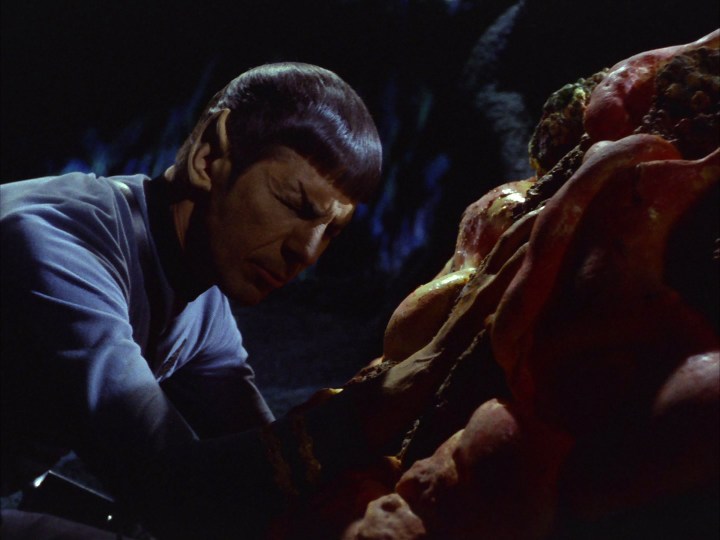
When Star Trek is running on full thrusters, it is equal parts silly and profound. In The Devil in the Dark, the Enterprise is sent to the aid of a mining colony where workers are being hunted and killed by an unstoppable monster made of rock. We know that the monster is made of rock because the characters say so; It looks a lot more like it’s made of spray-painted Styrofoam and a shag rug. But as the tension rises and the mystery deepens, the goofiness of the rock monster becomes irrelevant, or even a boon to the story.
Though it begins as a hunt for a merciless alien creature, The Devil in the Dark becomes a story about prejudice and the universality of what we (in our limited earthly experience) would call “basic human rights.” This message is conveyed through cheesy 1960s TV production values and some very hammy acting, but the results are pure and unpretentious, the sort of storytelling that is equally impactful on a jaded adult and a wide-eyed child.
Here in the post-post-postmodern 2020s, we’re all total pros at deconstructing genre tropes. The practice of subverting the audience’s expectations as to what kind of story they’re watching or who the good guys and bad guys are wasn’t new in 1967, either, but in the sci-fi film and television of the era, the big scary monster is usually just a big scary monster. The Devil in the Dark exemplifies one of Star Trek’s most enduring themes: that the unknown might seem terrifying, but if you take the time to understand it, it’s actually beautiful.
4. The Trouble with Tribbles (season 2, episode 15)
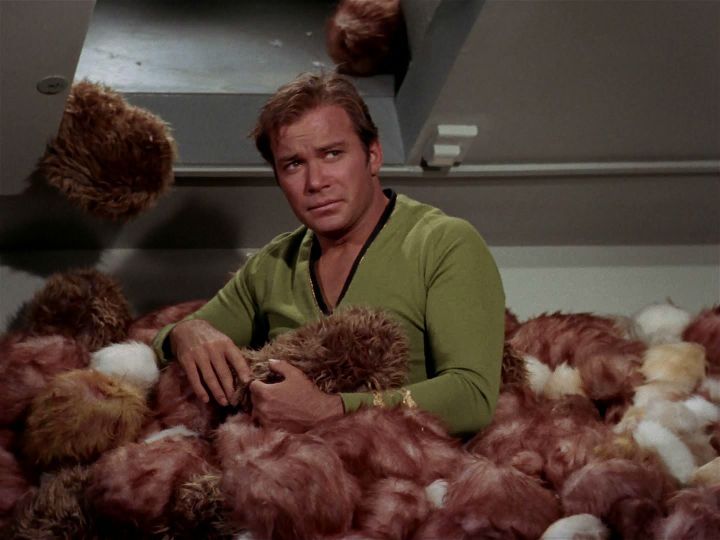
Star Trek is always science fiction, but its format offers a lot of flexibility in terms of how to interpret that genre. Even within the course of a single series or season, most Star Trek shows alternate between a variety of tones and secondary genres, from grim political drama to steamy romance, or in the case of this episode, kooky workplace comedy. The Trouble with Tribbles pits Captain Kirk and his gallant crew against their most stubborn foe yet — bureaucratic red tape. Assigned to look after a container of grain that Federation administrators insist is gravely important, the Enterprise becomes entangled in a very silly misadventure involving an invasive species of adorable, self-replicating furballs. For a captain accustomed to dealing with high-stakes diplomacy and galactic defense, this is his worst workweek ever.
As lousy a time as Kirk is having, The Trouble with Tribbles is tremendous fun. It is neither the first, nor the last broadly comedic episode of Star Trek, but it is the gold standard by which all Trek comedies are measured. Like any good Trek, it has stakes, a fun science fiction premise, and charming moments of character, but everything is set just a little bit askew, and the characters have noticed. It isn’t parody, it’s situation comedy, only a situation that you’re unlikely to find yourself in unless you’re the crew of a Federation starship. Almost every subsequent Trek series would chase that Trouble with Tribbles heat at least once (Star Trek: Lower Decks is basically The Trouble with Tribbles: The Series), with varying levels of success, but the original remains an untouchable classic.
3. Where No Man Has Gone Before (season 1, episode 4)
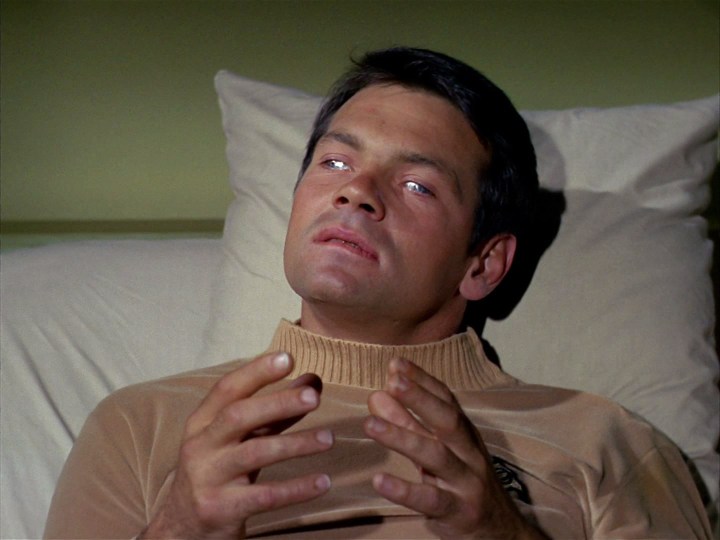
After The Cage was rejected by NBC, Desilu Studios (under the leadership of comedy queen Lucille Ball herself) took a second swing at the series, with a new cast and a faster paced action-adventure story. This second pilot, Where No Man Has Gone Before, introduces William Shatner as Captain James T. Kirk, as well as George Takei as Lt. Sulu, James Doohan as Scotty, and Leonard Nimoy’s new, more stoic interpretation of science officer Spock.
The episode sees Kirk’s friend and mentee, helmsman Gary Mitchell (guest star Gary Lockwood), bombarded with cosmic radiation that grants him increasingly godlike powers. As Gary grows more dangerous and cruel, Kirk must weigh his love for his friend against his duty to his crew. The scenario immediately establishes the dynamic between Kirk and Spock (compassionate leader versus his coldly practical advisor), though Spock’s regular debate partner, the emotionally driven Dr. McCoy (DeForest Kelley), would not appear until Trek was ordered to series.
Where No Man Has Gone Before is a little less fun and colorful than the episodes that followed, with a tone more closely resembling heady 1950s sci-fi films like Forbidden Planet or The Day the Earth Stood Still. In a way, it’s the classic Trek episode that feels the most like Star Trek: The Next Generation; It’s talky, deliberately paced, just a little bit sterile. In Where No Man Has Gone Before, the galaxy is not only wondrous, but also eerie and unsettling. Had this been the tone the series stuck with, it might not have become a global sensation, but as a single episode, it stands out as one of the very best.
2. The City on the Edge of Forever (season 1, episode 29)
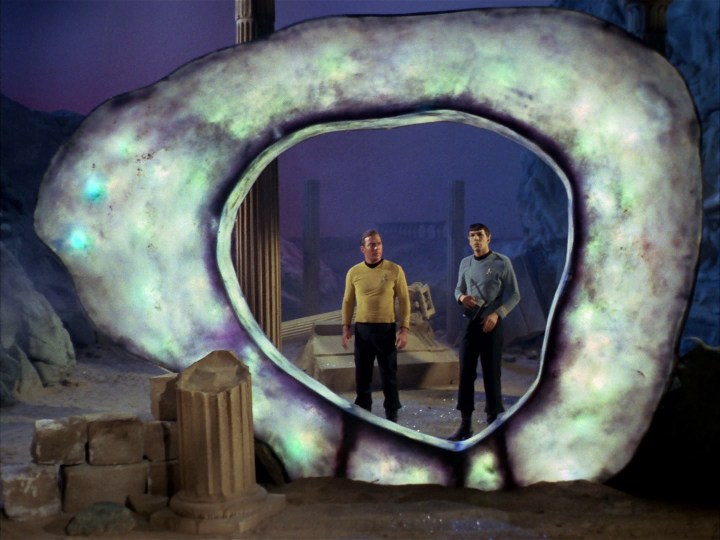
To some Trekkies, ranking The City on the Edge of Forever anywhere but at No. 1 is unthinkable. This time travel tale – written by sci-fi author Harlan Ellison and then heavily revised by Trek story editor D.C. Fontana — won Star Trek its first Hugo Award, and is widely considered to be the finest hour in the history of the series, if not the franchise as a whole. The episode’s legendary status is well-deserved, but we don’t quite have the heart to declare it the ultimate Star Trek episode, on account of how little of it takes place in the 23rd century or aboard the Starship Enterprise. The City on the Edge of Forever is an outlier, and as such, naturally stands apart from the pack, giving it an edge in any conversation about Star Trek. Its placement here at No. 2 is sort of a counter to that advantage.
Make no mistake, however — despite mostly being set in New York in the year 1930, City on the Edge is Star Trek to its core. Sent back in time to correct an accidental alteration of Earth’s history, Kirk and Spock take up residence in a homeless shelter run by idealistic philanthropist Edith Keeler (guest star Joan Collins). Keeler turns out to be the key historical figure whose destiny must be fulfilled, but there’s a problem — Kirk has fallen in love with her. This romance complicates the mission, as Kirk and Spock are confronted with a grave moral dilemma with their entire reality hanging in the balance. Keeler is a visionary who believes in the beautiful future that Kirk calls home. But, in order for that future to exist, must something terrible be allowed to happen in her present? It’s an emotionally gripping tale that, if it had been told on a modern television show, would have changed its characters forever.
1. Balance of Terror (season 1, episode 15)
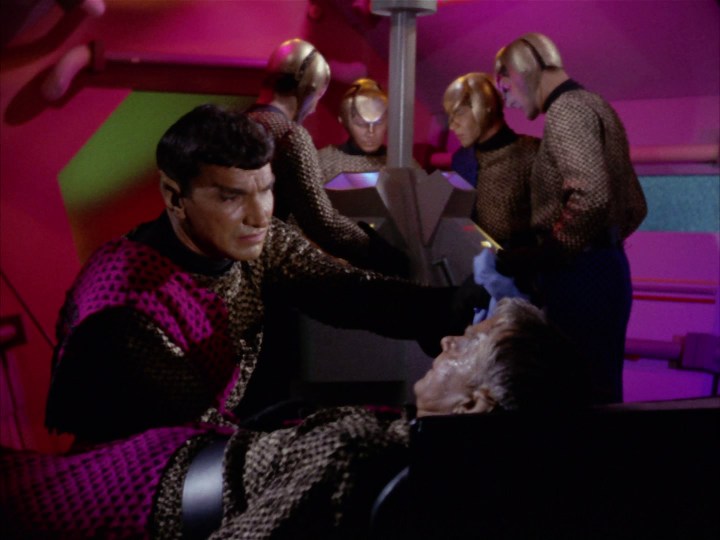
Star Trek is built on a central contradiction. It’s an adventure series about officers in a fleet that we are told, unconvincingly, is not a military organization, aboard a vessel that carries enough firepower to demolish a continent. It’s a show about peace in which things have a habit of blowing up. To reconcile this cognitive dissonance, one need only look to this key episode of The Original Series, Balance of Terror. In this early chapter, the Enterprise witnesses an Earth base being destroyed by an old enemy, the Romulan Empire. The Romulan ship has the ability to become invisible both to scanners and the naked eye, and attempts to escape to its own side of the neutral zone between their two territories before it can be apprehended.
The Enterprise is ordered to capture or destroy the Romulans before they make it home. Whether or not they succeed, there may be war. Kirk has his orders, and as we soon discover, so does the Romulan commander (guest star Mark Lenard), who is no happier about this turn of events than Kirk is. Throughout the episode, we cut back and forth between the action on the Enterprise and aboard the Romulan vessel, as two keen military strategists attempt to outmaneuver each other and stay alive, both locked in a struggle they’d rather had never begun.
Balance of Terror is a sci-fi twist on a submarine battle, but more than that, it’s a commentary on war, the rivalries between nations, and the wounds and prejudices they create. The Enterprise isn’t loaded with photon torpedoes because Starfleet is itching for a fight — it’s armed because sometimes it has to be, and when Kirk and his crew ride into battle, there’s nothing glorious about it. On the other side of any conflict is a person or people who have their own mission, their own values, and perhaps even their own reservations about fighting. It is not possible to avoid every fight, to preempt every war with diplomacy. But when blood is shed, there is no victory and there are no winners. There is tragedy, and there are survivors. And, finally, there’s the hope that the next time these two nations clash, they’ll be a little more willing to talk to one another.



